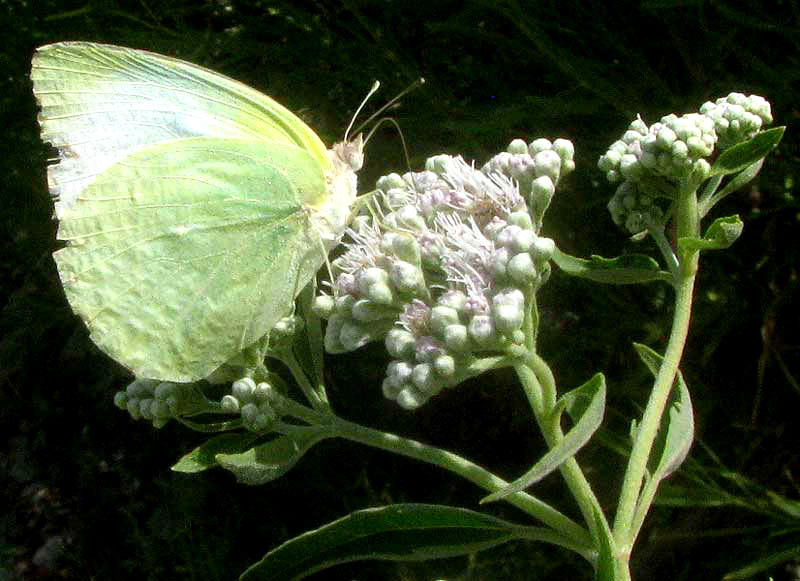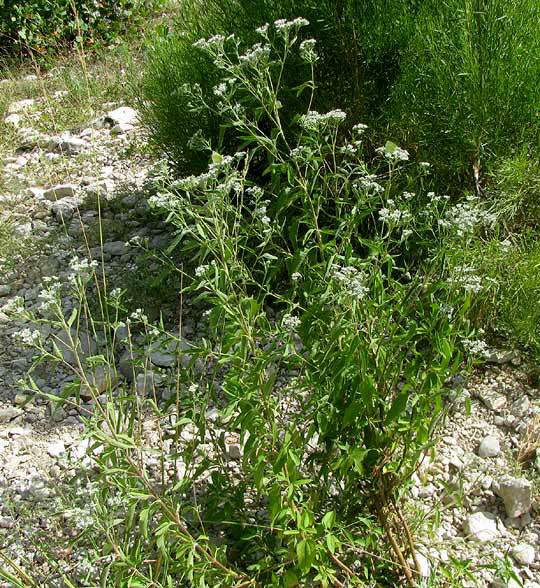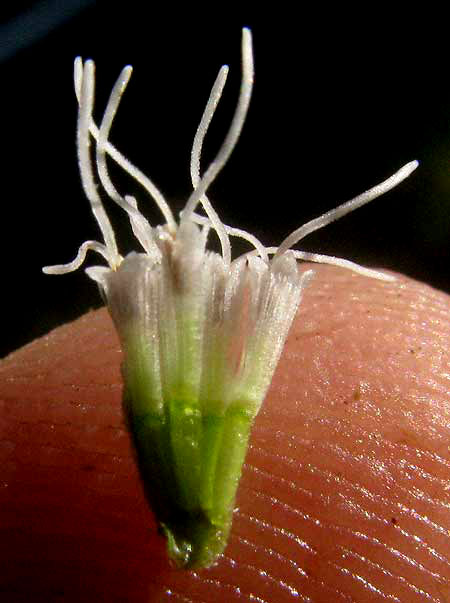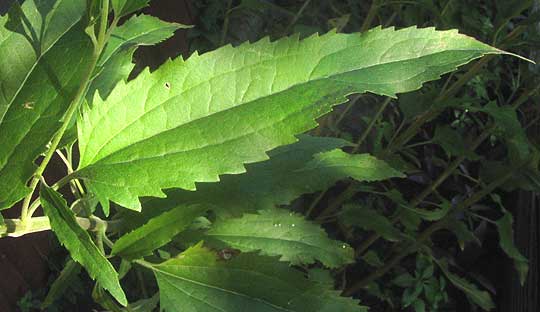Excerpts from Jim Conrad's
Naturalist Newsletter

from the August 25, 2013 Newsletter issued from the Frio Canyon Nature Education Center in the valley of the Dry Frio River in northern Uvalde County, southwestern Texas, on the southern border of the Edwards Plateau; elevation ~1750m (~5750 ft); N29.62°, W99.86°; USA
BONESET
When I arrived here one year ago this week I was pleased to see growing behind the red cabin in which I would live most of the following year a white-flowered, shoulder-high member of the Composite or Sunflower Family busily attracting prodigious numbers of butterflies. When I sniffed it I understood why, for its eupatorium-type flower heads smelled like the richest of honeys.
Was this a member of the local flora an enlightened previous occupant of the cabin had planted, or an ornamental, maybe planted especially for butterflies, since really its flowers weren't particularly spectacular? I guessed it was a planted cultivar, else I would have heard about such a sweet-smelling native.
The cabin plant died back in the winter but sprouted in the spring, and now is even more robust and good smelling than last year, maybe because I watered it during my occupancy. And to my surprise, nowadays you can find the same species growing in the wild here, especially on the Dry Frio River's dry gravel and cobblestone bed. You can see a typically bushy wild plant below:

A close-up of clusters of flowering heads being visited by a Lyside Sulphur butterfly appears at the top of this page.
There you can see that each head is composed of several tiny flowers crammed together inside a bowl-like structure, typical of the Composite Family. Also, all the flowers are cylindrical disc flowers, though most Composite Family genera produce heads bearing at least some petal-like ray flowers with flat corollas. Breaking open a head and removing several cylindrical disc flowers, you see what's stuck to my fingertip below:

The green bottom parts of each flower are the future cypsela-type fruits, each cypsela bearing a single seed within its non-fleshy cover. The slender, white items curving up from inside each five-lobed corolla are style branches arising from atop the ovaries.
A typical leaf with saw-toothed margins and principle veins arising near the midvein's base is shown below:

If you pay attention to eastern North American wildflowers, probably you already recognize this plant as a member of the genus Eupatorium, species of which often are referred to as thoroughworts and bonesets. Several Eupatorium species occur as common wildflowers and weeds in eastern North America, though this far west and south, this species is our only one.
Common throughout all but the northernmost states of the eastern US, this plant goes by several names, including Lateflowering Thoroughwort, White Boneset, Late Boneset and Late-flowering Boneset. It's EUPATORIUM SEROTINUM, described as living in moist to dry situations in open areas including roadsides, so you can see that it's not too persnickety about where it lives.
And the funny thing is that back in Kentucky and Mississippi I've met this species many times, and thought I knew it very well. I just didn't know that if you water it and provide it with rich soil in a flowerbed behind a cabin in Texas, it could grow so large, produce such sweet fragrance, and attract so many butterflies.
In Virgil Vogel's American Indian Medicine partially available via Google Books, I read that, before their cultural annihilation, Alabama indigenous Americans used Lateflowering Boneset for stomach pains. Despite the "boneset" in its name, this species doesn't seem to have been used for setting bones. Though several eupatoriums are referred to as bonesets, the "real" boneset is Eupatorium perfoliatum. Moreover, though indigenous Americans used Eupatorium perfoliatum for many cures, it's uncertain whether bone-setting was one of them. The plant may have served as a cure for Dengue Fever, which makes you ache so that it feels as if your bones are breaking.
Whatever the case with setting bones, our Lateflowering Boneset is a very attractive species if only because it attracts so many butterflies, at least when it's watered and grows in rich soil. It also produces huge numbers of tiny cypsela-type fruits that small, seed-eating birds eat. And, around here there's yet another good reason why a butterfly-loving gardener might want to grow Lateflowering Boneset: Deer don't seem to eat it.